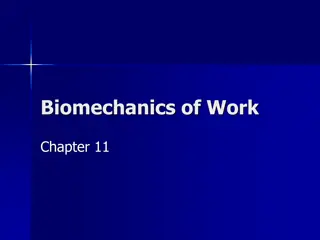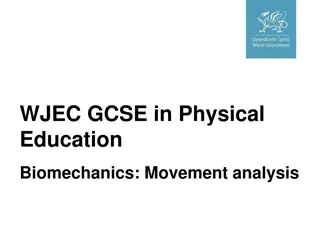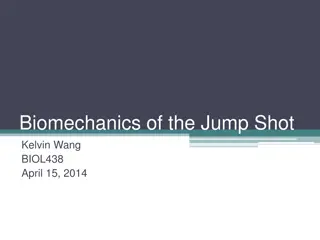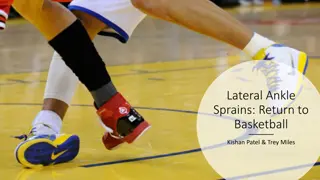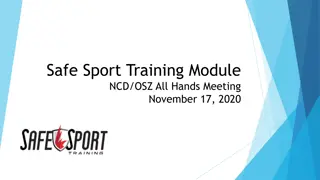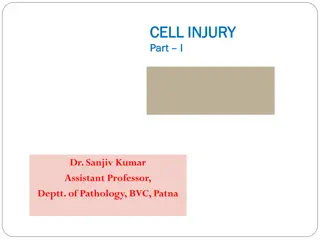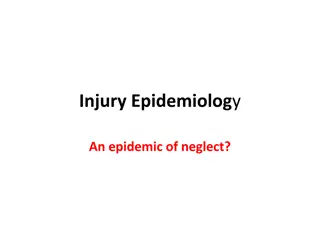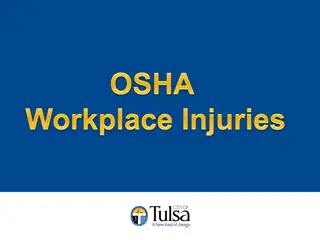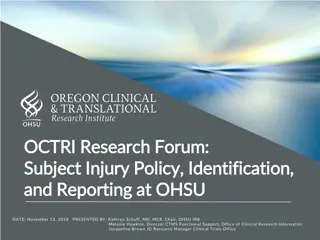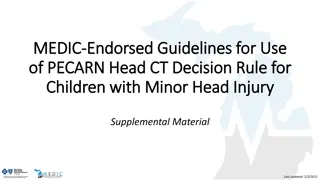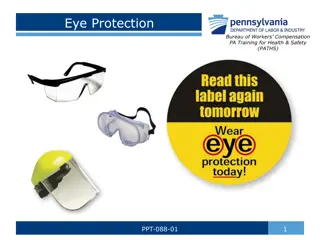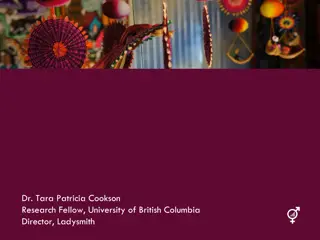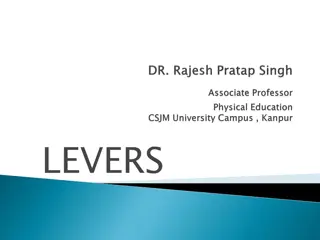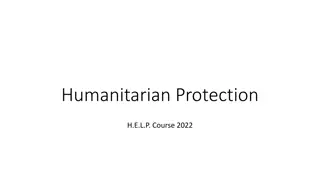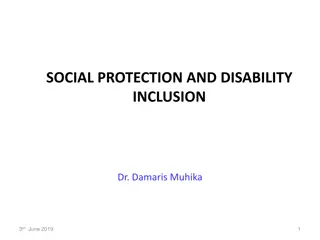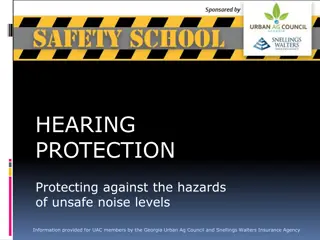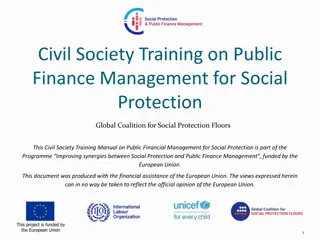Understanding Biomechanics of Sport Injury for Improved Protection
Identification of the causes and mechanisms of sports injuries through biomechanics is crucial for enhancing prevention strategies. This field explores how the human body responds to mechanical forces, risking injury if tissues fail to absorb stress. Impact injuries can lead to structural damage and functional alterations, highlighting the importance of studying injury biomechanics to minimize risks and enhance recovery processes.
Download Presentation

Please find below an Image/Link to download the presentation.
The content on the website is provided AS IS for your information and personal use only. It may not be sold, licensed, or shared on other websites without obtaining consent from the author. Download presentation by click this link. If you encounter any issues during the download, it is possible that the publisher has removed the file from their server.
E N D
Presentation Transcript
Biomechanics of Sport Injury Dr. Saeed Ilbeigi Faculty of Sport Sciences University of Birjand
Introduction The identification of cause and reason of injury and also improved protection against injury can be realized through a better understanding of the biomechanics of injury and disability.
Introduction Although physical activity is associated with an overall reduction in mortality, morbidity and an improved quality of life, it also carries an increased risk of injury and disability.
An injury occurs when the stress applied to a tissue is greater than its ability to absorb the stress acutely or chronically. This results from complex interactions between internal and external risk factors.
Impact injury of the human body occurs by deformation of tissues beyond their failure limits, which results in damage of anatomic structures or alteration in function. Even if there is recovery from structural injury, normal physiologic function does not always return. For example, bony fractures can heal, but associated damage to the central nervous tissue might result in a permanent loss of motor and sensory function.
Why Biomechanics of Injury Injury biomechanics research uses the principles of mechanics to explore the mechanisms of physical and physiologic responses to mechanical forces.
Why Biomechanics of Injury Research in biomechanics involves a variety of disciplines, including: engineering, physiology, medicine, biology, and anatomy.
Mechanisms of Injury The severity of an impact depends not only on the velocity of the collision that produces it, but also on the shapes of the objects and their rigidity and also the type of forces that applied. It can be reduced by energy-absorbing structures and padding material by allowing simultaneous deformation of the body.
Because of the inertial resistance of the tissues and the elastic and viscous of the body structures, force is developed on the body during impact. Force deforms and accelerates the body. Injury (Figure 4-1) can be caused by:
Figure 1: Three principal mechanisms of impact injury: left, compression of the body and injury when the crush exceeds elastic tolerances; center, high-speed impact with injury when violence exceeds viscous tolerance; right, body acceleration when internal organ motion lags the skeleton with injury due to organ inertia.
Crushing deformation of the body, such as through chest compression, rib fracture, and aortic laceration. Impulsive impact, such as by violent sternal motion that deforms the heart beyond its viscous tolerance and causes contusion and rupture. Acceleration of the skeleton and tearing of internal organs, because of their inertia; for example, during head impact, the skull accelerates and the loosely attached brain lags,so injury is due in part to deformation of brain tissues beyond their limit of recovery.
A mechanism of injury involves the mechanical deformations and physiologic responses that cause an anatomic lesion or functional change. Knowledge of injury mechanisms is fundamental to the science of injury biomechanics, because it points to the appropriate biomechanical measurements that characterize injuries.
viscoelastic tissues The human body has viscoelastic tissues that absorb energy and protect vital organs from the effects of impact.
As long as the energy delivered to the tissue is below the limit of injury energy will be absorbed without causing injury. The resistance of the human body to impact is responsible for survival of falls from extreme heights and survival of severe motor-vehicle crashes.
Effective injury-prevention strategies must be based on knowledge of the mechanisms of injury and disability, as well of the body's biomechanical responses and tolerances and techniques for assessing the injury-prevention benefits of safety technology.
Deformation of tissues beyond a recoverable limit is the most common origin of injury. From an engineering point of view, deformation of a tissue or structure is measured according to change in shape (such as the change in length divided by the initial length) or strain. The two main types of strain (Figure 4-2) that can damage tissue are tensile strain and shear strain; a third type is compressive strain, which is responsible for crushing injuries. And also Torsion and Bending.
Figure: 2 Stretch of vessel can tear tissue (partial tear shown) with loss or containment of blood. Opposing forces across vessel can cause shear injury (complete tear shown) with or without loss of blood.
Stretching of an artery increases its length and increases strain. If the strain is too great, the tissue will break. There are many ways to stretch tissue and thus produce tensile strain.
For example, the motion of the heart during chest compression stretches the aorta near points of attachment; the stretch is primarily along the axis of the vessel and generally leads to a transverse laceration when the recoverable limit of tissue strain is exceeded. An increase in vascular pressure enlarged blood vessels and produces tensile strain in the tissue; in this case, the strain is in both axial and transverse directions (i.e., it is biaxial), and pressures beyond the recoverable limit cause a bursting of the tissue.
Shear strain occurs when forces oppose each other across a tissue (see Figure 4-2). The movement of tissue in opposite directions separates it when the recoverable limit is exceeded.
Figure: 3 Vessels beneath skin can be torn by stretch or shear with laceration of skin, resulting in bruise, or contusion.
Stretch and shear of tissue are the primary mechanisms of laceration, fracture, rupture, and avulsion in the human body.
Deformation or strain is also a principal factor in contusion injury (Figure 4-3). In this case, the surface of the tissue is not damaged, but the deformations stretch and shear internal vessels and increase intraluminal pressures, which can damage vessels and initiate hemorrhage.
The rate of loading, or strain rate, is important in the production of injury. Biologic tissues are viscoelastic, and their response and tolerance depend on both strain and strain rate. For example, compact bone fails at a lower strain applied at higher rates, even though the load it carries at failure is higher.
The rate of loading is critical in soft-tissue injury, particularly when the viscous tolerance of the tissue is exceeded.This tolerance is proportional to the product of loading rate and amount of compression. The faster a tissue is loaded, the lower is its tolerance to compression. The viscous injury mechanism is important in cases of high-speed impact, particularly when rupture and contusion occur.
How can biomechanics prevent sports injuries? Experiencing an injury in any sport is impossible to avoid, but it has been found new ways that may be able to reduce the amount of occurrences. The studies are led by analyzing biomechanics, which is designed to simplify the way we understand the motion of the human body. Biomechanics has been found highly effective in preventing injuries ,but how?
Load . . . ... ...


